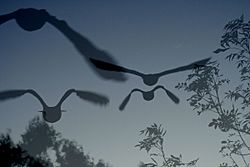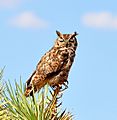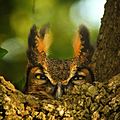Great horned owl facts for kids
Quick facts for kids Great horned owl |
|
|---|---|
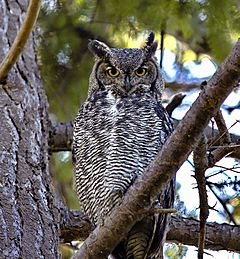 |
|
| Coastal great horned owl, B. v. saturatus | |
| Conservation status | |
| Scientific classification | |
| Kingdom: | |
| Phylum: | |
| Class: | |
| Order: | |
| Family: | |
| Genus: | |
| Species: |
Bubo virginianus
|
The Great Horned Owl (Bubo virginianus) is the biggest owl in North America. People sometimes call it the hoot owl because of its sound.
This amazing bird of prey lives in many different places. You can find it in mountains, grasslands, conifer forests, deserts, and more. It lives all across North and South America. Its call is a loud "ho-ho-hoo hoo hoo" that travels far.
Contents
About the Great Horned Owl
Great Horned Owls are quite large. They can be from 46 to 68 cm (18 to 27 inches) long. Their wings can spread out from 101 to 152 cm (40 to 60 inches). An average owl is about 55 cm (22 inches) long. Its wingspan is around 124 cm (49 inches) and it weighs about 1400 grams (3.1 lbs).
Owls found closer to the North and South Poles are usually bigger. Those closer to the Equator are often smaller. Female owls are also larger than males.
Adult owls have big feather tufts that look like ears. They have a face that can be reddish, brown, or gray. A white patch is found on their throat. Their eyes are usually yellow. However, one type of Great Horned Owl (B. v. nacurutu) has amber-colored eyes.
The ear tufts are not real ears. They are just feathers! The owl's belly feathers are light with brown stripes. Its back feathers are mottled brown, which means they have patchy colors.
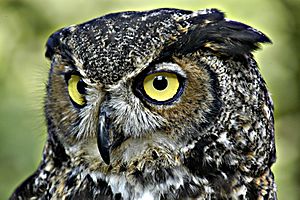
Their legs and feet are covered in feathers. These feathers go all the way down to their sharp talons. The color of these owls can change depending on where they live. Owls from very cold places are light buff. Those from Central America can be a dark chocolate brown.
Amazing Senses
Owls have incredible vision. They can see very well in the dark, which helps them find prey. Their eyes are fixed in their sockets, so they cannot move them like we do. To look around, an owl has to turn its whole head. They can turn their neck an amazing 270 degrees!
An owl's hearing is just as good as its vision, or even better. They have "stereo hearing." This means their ears are not placed in the same spot on each side of their head. One ear is usually a bit higher. This helps them figure out the exact direction and distance of a sound. It's like having super-powered sound radar!
Owl Sounds
The Great Horned Owl's call is a deep, loud "ho-ho-hoo hoo hoo." Sometimes it only has four sounds instead of five. Female owls have a higher-pitched call. It also rises in pitch at the end. Young owls make hissing or screeching sounds. These sounds are sometimes mistaken for Barn Owls.
Where Great Horned Owls Live
Great Horned Owls live in almost all of North America and South America. They can make their homes in many places. These include deciduous forests (trees that lose leaves), coniferous forests (trees with needles), and mixed forests. They also live in tropical rainforests, grasslands, prairies, mountains, deserts, and even some urban areas.
They are very good at adapting to different environments. This makes them one of the most flexible owls in the world when it comes to where they can live.
Hunting and Behavior
These birds hunt at night. They wait quietly on a high branch. When they spot prey, they swoop down quickly. They eat many different animals. Their main food is small to medium-sized mammals. This includes rats, squirrels, mice, rabbits, voles, skunks, and even porcupines. In some areas, hares and rabbits are a favorite meal.
Birds are another big part of their diet. They can catch birds from tiny kinglets to large Great Blue Herons. They even hunt other birds of prey, like Snowy Owls or Ospreys. Sometimes, they also eat Reptiles, amphibians, fish, and insects. In cold places, they might let uneaten food freeze. Then, they use their body heat to thaw it out later.
The Great Horned Owl is the provincial bird of Alberta, Canada.
Predators
Young owls, like eggs, chicks, and fledglings (young birds learning to fly), can be hunted by other animals. These include foxes, coyotes, wild cats, and raccoons.
Adult Great Horned Owls have very few predators. Sometimes, they might be killed by eagles or Snowy Owls. Most often, though, they are killed by other Great Horned Owls. In some rare cases, the winning owl might even eat the losing one.
Reproduction and Life Cycle
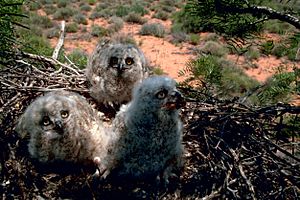
Great Horned Owls are some of the first birds to breed in North America each year. They start breeding in late January or early February. You can often hear them calling to each other in the fall, starting in October. They choose a mate by December.
They often take over a nest that another large bird used before. They might add a few feathers to line the nest, but not much else. Old nests of crows, Common Ravens, Red-tailed Hawks, and large squirrels are often chosen. However, they can also use holes in trees, cliffs, empty buildings, or special platforms made by humans.
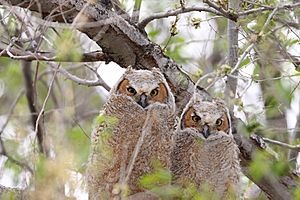
A female owl usually lays 2 eggs. Sometimes it can be 1 to 5 eggs, but 5 is very rare. The eggs are about 55.2 mm (2.2 inches) long and weigh about 51 grams (1.8 oz). The mother owl sits on the eggs for 30 to 37 days, usually 33 days.
The mother owl keeps the chicks warm almost all the time until they are about 2 weeks old. Young owls start moving to nearby branches when they are 6 weeks old. They begin to fly about a week later. They might still beg their parents for food until late October. Most young owls do not leave their parents until just before the next breeding season starts. Adult Great Horned Owls usually stay in their territory all year round.
Types of Great Horned Owls (Subspecies)
There are many different types, or subspecies, of Great Horned Owls. They look a bit different depending on where they live. Here are a few examples:
- Common Great Horned Owl: Found in the eastern USA and parts of eastern Canada. It's a brown owl with reddish tones and dark stripes.
- South American Great Horned Owl: Lives in parts of South America. This one is dull brownish and has amber eyes, unlike most others with yellow eyes.
- Northern/Subarctic Great Horned Owl: Found in northern Canada. This is a very pale owl, almost whitish, and is the largest type.
- Californian Great Horned Owl: Lives in central and southern California. It's a rich brown color.
- Coastal Great Horned Owl: Found along the Pacific coast from Alaska to northern California. This type is dark, dull, and grayish with heavy stripes.
- Desert Great Horned Owl: Lives in the dry regions of the southwestern USA and Mexico. This is a small, pale owl with faint stripes.
Images for kids
-
Desert great horned owl (B. v. pallescens) perched on the top of a Joshua tree in Landers, California
-
Coastal great horned owl (B. v. saturatus) at Grouse Mountain (North Vancouver, British Columbia)
-
Desert great horned owl (wet feathered) (B. v. pallescens) waiting out a rainstorm in the Mojave Desert
-
Mojave Desert, desert great horned owl (B. v. pallescens) on top of a Joshua tree in the summer of 2018
-
A large portion of the great horned owl's food consists of small rodents, such as white-footed mice.
-
Black-tailed jackrabbits are an important food source for western great horned owls.
-
American coots are often a favored food source for great horned owls living near wetlands.
-
A brooding female common great horned owl (B. v. virginianus) on her nest in Louisiana
See also
 In Spanish: Búho americano para niños
In Spanish: Búho americano para niños



